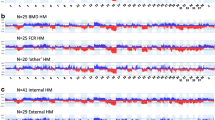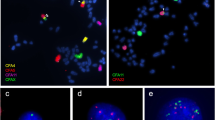Abstract
Mast cell tumor (MCT) is the most common skin malignancy of domestic dogs and presents with a widely variable clinical behavior. Although activating KIT mutations are present in approximately 20% of canine MCTs, molecular etiology is largely unknown for the majority of this cancer. Characterization of genomic alterations in canine MCTs may identify genomic regions and/or genes responsible for their development and progression, facilitating the discovery of new therapeutic targets and improved clinical management of this heterogeneous cancer. We performed genome-wide DNA copy number analysis of 109 primary MCTs derived from three popular canine breeds (the Boxer, Labrador Retriever, and Pug) as well as nontarget breeds using oligonucleotide array comparative genomic hybridization (oaCGH). We demonstrated a stepwise accumulation of numerical DNA copy number aberrations (CNAs) as tumor grade increases. DNA sequencing analysis revealed that KIT mutations were found less frequently in the Pug tumors and were strongly associated with high histological grade. Tumors with KIT mutations showed genome-wide aberrant copy number profiles, with frequent CNAs involving genes in the p53 and RB pathways, whereas CNAs were very limited in tumors with wild-type KIT. We evaluated the presence of four CNAs to predict aggressive tumor phenotypes. This approach predicted aggressive tumors with a sensitivity of 78–94% and specificity of 88–93%, when using oaCGH and droplet digital PCR platforms. Further investigation of genome regions identified in this study may lead to the development of a molecular tool for classification and prognosis, as well as identification of therapeutic target molecules.






Similar content being viewed by others
Abbreviations
- CFA:
-
Canis familiaris (also used as a prefix to chromosome numbers)
- CI:
-
Confidence interval
- CNA:
-
Copy number aberration
- ddPCR:
-
Droplet digital PCR
- FFPE:
-
Formalin fixed paraffin embedded
- GISTIC:
-
Genomic Identification of Significant Targets in Cancer
- ITD:
-
Internal tandem duplication
- MCT:
-
Mast cell tumor
- mut-KIT :
-
Mutant KIT
- oaCGH:
-
Oligonucleotide array comparative genomic hybridization
- OR:
-
Odds ratio
- ROC:
-
Receiver operating characteristic
- wt-KIT :
-
Wild-type KIT
References
Angstadt AY, Motsinger-Reif A, Thomas R et al (2011) Characterization of canine osteosarcoma by array comparative genomic hybridization and RT-qPCR: signatures of genomic imbalance in canine osteosarcoma parallel the human counterpart. Genes Chromosomes Cancer 50:859–874
Arendt ML, Melin M, Tonomura N et al (2015) Genome-wide association study of golden retrievers identifies germ-line risk factors predisposing to mast cell tumours. PLoS Genet 11:e1005647
Beroukhim R, Getz G, Nghiemphu L et al (2007) Assessing the significance of chromosomal aberrations in cancer: methodology and application to glioma. Proc Natl Acad Sci U S A 104:20007–20012
Bhat S, Curach N, Mostyn T, Bains GS, Griffiths KR, Emslie KR (2010) Comparison of methods for accurate quantification of DNA mass concentration with traceability to the international system of units. Anal Chem 82:7185–7192
Bhat S, Mclaughlin JL, Emslie KR (2011) Effect of sustained elevated temperature prior to amplification on template copy number estimation using digital polymerase chain reaction. Analyst 136:724–732
Bonkobara M (2015) Dysregulation of tyrosine kinases and use of imatinib in small animal practice. Vet J 205:180–188
Downing S, Chien MB, Kass PH, Moore PE, London CA (2002) Prevalence and importance of internal tandem duplications in exons 11 and 12 of c-kit in mast cell tumors of dogs. Am J Vet Res 63:1718–1723
Elvers I, Turner-Maier J, Swofford R et al (2015) Exome sequencing of lymphomas from three dog breeds reveals somatic mutation patterns reflecting genetic background. Genome Res 25(11):1634–1645
Finnie JW, Bostock DE (1979) Skin neoplasia in dogs. Aust Vet J 55:602–604
Frohling S, Dohner H (2008) Chromosomal abnormalities in cancer. N Engl J Med 359:722–734
Giantin M, Granato A, Baratto C et al (2014) Global gene expression analysis of canine cutaneous mast cell tumor: could molecular profiling be useful for subtype classification and prognostication? PLoS One 9:e95481
Haenisch B, Nöthen MM, Molderings GJ (2012) Systemic mast cell activation disease: the role of molecular genetic alterations in pathogenesis, heritability and diagnostics. Immunology 137:197–205
Hahn KA, Legendre AM, Shaw NG et al (2010) Evaluation of 12- and 24-month survival rates after treatment with masitinib in dogs with nonresectable mast cell tumors. Am J Vet Res 71:1354–1361
Hanahan D, Weinberg RA (2011) Hallmarks of cancer: the next generation. Cell 144:646–674
Hedan B, Thomas R, Motsinger-Reif A et al (2011) Molecular cytogenetic characterization of canine histiocytic sarcoma: a spontaneous model for human histiocytic cancer identifies deletion of tumor suppressor genes and highlights influence of genetic background on tumor behavior. BMC Cancer 11(201)
Kiupel M, Webster JD, Bailey KL et al (2011) Proposal of a 2-tier histologic grading system for canine cutaneous mast cell tumors to more accurately predict biological behavior. Vet Pathol 48:147–155
Letard S, Yang Y, Hanssens K et al (2008) Gain-of-function mutations in the extracellular domain of KIT are common in canine mast cell tumors. Mol Cancer Res 6:1137–1145
Lin TY, Thomas R, Tsai PC, Breen M, London CA (2009) Generation and characterization of novel canine malignant mast cell line CL1. Vet Immunol Immunopathol 127:114–124
London CA, Malpas PB, Wood-Follis SL et al (2009) Multi-center, placebo-controlled, double-blind, randomized study of oral toceranib phosphate (SU11654), a receptor tyrosine kinase inhibitor, for the treatment of dogs with recurrent (either local or distant) mast cell tumor following surgical excision. Clin Cancer Res 15:3856–3865
Mcniel EA, Prink AL, O'brien TD (2006) Evaluation of risk and clinical outcome of mast cell tumours in pug dogs. Vet Comp Oncol 4:2–8
Mitelman F, Johansson B, Mertens F (2007) The impact of translocations and gene fusions on cancer causation. Nat Rev Cancer 7:233–245
Mochizuki, H, Motsinger-Reif, A, Bettini, C, Moroff, S, Breen, M (2016a) Association of breed and histopathological grade in canine mast cell tumours. Veterinary and Comparative Oncology.
Mochizuki H, Shapiro SG, Breen M (2016b) Detection of copy number imbalance in canine urothelial carcinoma with droplet digital polymerase chain reaction. Vet Pathol 53:764–772
Northrup NC, Harmon BG, Gieger TL et al (2005) Variation among pathologists in histologic grading of canine cutaneous mast cell tumors. J Vet Diagn Investig 17:245–248
Patnaik AK, Ehler WJ, Macewen EG (1984) Canine cutaneous mast cell tumor: morphologic grading and survival time in 83 dogs. Vet Pathol 21:469–474
Poorman K, Borst L, Moroff S et al (2015) Comparative cytogenetic characterization of primary canine melanocytic lesions using array CGH and fluorescence in situ hybridization. Chromosom Res 23:171–186
Roode, SC, Rotroff, D, Avery, AC, et al. (2015) Genome-wide assessment of recurrent genomic imbalances in canine leukemia identifies evolutionarily conserved regions for subtype differentiation. Chromosome Res.
Roskoski R Jr (2005) Signaling by kit protein-tyrosine kinase—the stem cell factor receptor. Biochem Biophys Res Commun 337:1–13
Rothwell TL, Howlett CR, Middleton DJ, Griffiths DA, Duff BC (1987) Skin neoplasms of dogs in Sydney. Aust Vet J 64:161–164
Sabattini S, Scarpa F, Berlato D, Bettini G (2015) Histologic grading of canine mast cell tumor: is 2 better than 3? Vet Pathol 52:70–73
Shapiro SG, Raghunath S, Williams C et al (2015) Canine urothelial carcinoma: genomically aberrant and comparatively relevant. Chromosom Res 23:311–331
Shoop S, Marlow S, Church D et al (2015) Prevalence and risk factors for mast cell tumours in dogs in England. Canine Genetics and Epidemiology 2:1–10
Stefanello D, Buracco P, Sabattini S et al (2015) Comparison of 2-and 3-category histologic grading systems for predicting the presence of metastasis at the time of initial evaluation in dogs with cutaneous mast cell tumors: 386 cases (2009–2014). J Am Vet Med Assoc 246:765–769
Takeuchi Y, Fujino Y, Watanabe M et al (2013) Validation of the prognostic value of histopathological grading or c-kit mutation in canine cutaneous mast cell tumours: a retrospective cohort study. Vet J 196:492–498
Thomas R, Borst L, Rotroff D et al (2014) Genomic profiling reveals extensive heterogeneity in somatic DNA copy number aberrations of canine hemangiosarcoma. Chromosom Res 22:305–319
Thomas R, Duke SE, Wang HJ et al (2009) ‘Putting our heads together’: insights into genomic conservation between human and canine intracranial tumors. J Neuro-Oncol 94:333–349
Thomas R, Seiser EL, Motsinger-Reif A et al (2011) Refining tumor-associated aneuploidy through ‘genomic recoding’ of recurrent DNA copy number aberrations in 150 canine non-Hodgkin lymphomas. Leuk Lymphoma 52:1321–1335
Villamil JA, Henry CJ, Bryan JN et al (2011) Identification of the most common cutaneous neoplasms in dogs and evaluation of breed and age distributions for selected neoplasms. J Am Vet Med Assoc 239:960–965
Warland J, Dobson J (2013) Breed predispositions in canine mast cell tumour: a single centre experience in the United Kingdom. Vet J 197:496–498
Webster JD, Yuzbasiyan-Gurkan V, Kaneene JB, Miller R, Resau JH, Kiupel M (2006) The role of c-kit in tumorigenesis: evaluation in canine cutaneous mast cell tumors. Neoplasia 8:104–111
White CR, Hohenhaus AE, Kelsey J, Procter-Gray E (2011) Cutaneous mcts: associations with spay/neuter status, breed, body size, and phylogenetic cluster. J Am Anim Hosp Assoc 47:210–216
Zemke D, Yamini B, Yuzbasiyan-Gurkan V (2002) Mutations in the juxtamembrane domain of c-kit are associated with higher grade mast cell tumors in dogs. Vet Pathol 39:529–535
Acknowledgements
This study was funded in part by a grant from Antech Diagnostics (awarded to MB) and by the NCSU Cancer Genomics fund (MB). HM was supported in part by a Morris Animal Foundation Fellowship (awarded to HM, study ID: D14CA-401) and a Postdoctoral Fellowship for Research Abroad, provided by the Japan Society for the Promotion of Science (HM).
Author information
Authors and Affiliations
Corresponding author
Ethics declarations
Ethical standards
The experiment complies with the current laws of the country, the USA, in which they were performed.
Studies of human or animal subjects
This article does not contain any studies with human or animal subjects performed by the any of the authors.
Additional information
Responsible Editor: Conly Rieder
Electronic supplementary material
ESM 1
(XLS 235 kb)
Rights and permissions
About this article
Cite this article
Mochizuki, H., Thomas, R., Moroff, S. et al. Genomic profiling of canine mast cell tumors identifies DNA copy number aberrations associated with KIT mutations and high histological grade. Chromosome Res 25, 129–143 (2017). https://doi.org/10.1007/s10577-016-9543-7
Received:
Revised:
Accepted:
Published:
Issue Date:
DOI: https://doi.org/10.1007/s10577-016-9543-7




